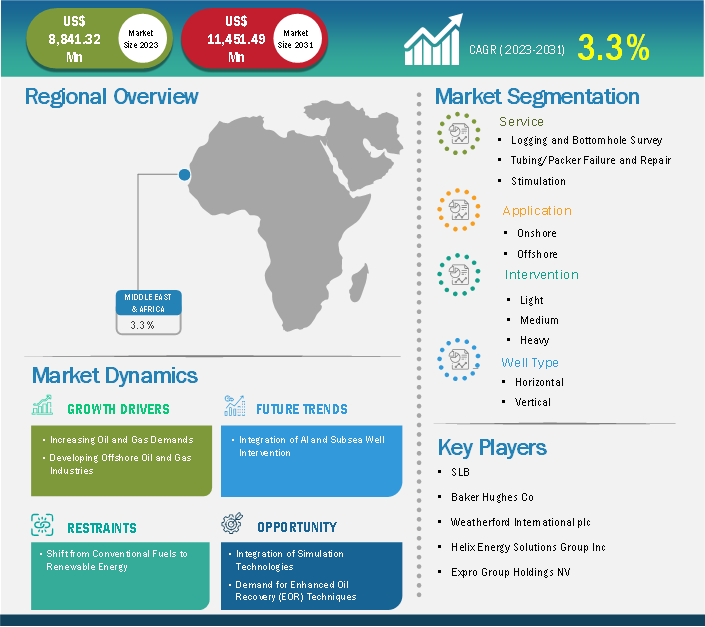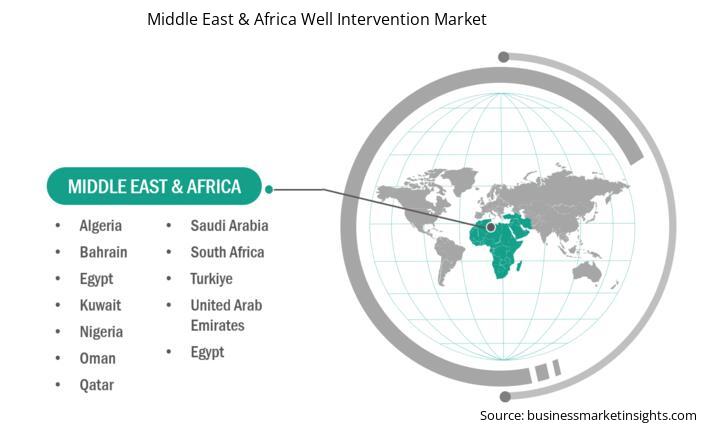Middle East & Africa Well Intervention Market Report (2021-2031) by Scope, Segmentation, Dynamics, and Competitive Analysis
No. of Pages: 147 | Report Code: BMIRE00031805 | Category: Energy and Power
No. of Pages: 147 | Report Code: BMIRE00031805 | Category: Energy and Power
The Middle East & Africa Well Intervention Market size is expected to reach US$ 11,451.49 million by 2031 from US$ 8,841.32 million in 2023. The market is estimated to record a CAGR of 3.3% from 2023 to 2031.
According to the International Energy Agency (IEA), the Middle East and Africa generated ~95% of their electricity from oil and gas in 2023. Thermal plants in the region consume more than 290 billion cubic meters of gas (i.e., more than one-third of domestic gas production) and 1.75 million barrels of oil per day. In November 2023, Shell Egypt announced the completion of drilling of the first well—Mina West, located in the Northeast El-Amriya block in the Mediterranean Sea—in its three-well exploration campaign. Prominent factors driving the growth of the well intervention market in the Middle East and Africa region include rising onshore and offshore oil and gas drilling activities, the discovery of new locations to establish drilling wells, and increasing output targets for offshore oil and gas production. Oil- and gas-producing economies in the Middle East and North Africa rely heavily on fossil fuels, which raises the carbon intensity of their electricity generation by approximately a fifth compared to the global average. In May 2023, the Abu Dhabi National Oil Company (ADNOC) granted three contracts totaling US$ 4 billion to reduce carbon emissions and reach a production capacity of 5 million barrels per day by 2030. The contracts are valid for 5 years with a 2-year extension option, entailing ADNOC's onshore and offshore operations. Thus, the growing emphasis on the adoption of practices promoting carbon-neutral oil and gas production is anticipated to offer lucrative growth opportunities to the well intervention market in the Middle East and Africa in the coming years.

Key segments that contributed to the derivation of the well intervention market analysis are service, application, intervention, and well type.
Subsea well intervention, leveraging new technologies and innovative approaches, holds exciting growth avenues for the well intervention market players. Technologies meant to aid in subsea operations are designed to enhance their safety, increase their efficiency, and optimize their cost-effectiveness. Advanced data collection and analysis techniques play a critical role in subsea well interventions. Real-time monitoring systems collect massive amounts of data from subsea sensors and provide insights into the health and performance of wells. By using data analytics, engineers can detect anomalies, predict potential problems, and optimize intervention strategies. This data-driven approach enables proactive maintenance and minimizes the risk of unplanned downtime, improving the overall reliability and productivity of subsea oil and gas wells.
Oil and gas companies these days operate on tight margins. Therefore, a key goal is to maximize production from existing facilities as efficiently and economically as possible. A strategic well intervention program can help achieve this goal. The pre-planning of these processes includes evaluating candidates, intervention methods, and expected value. For example, an artificial intelligence (AI) and automation solution from SLB solutions is claimed to decrease the well review time from 3 days per well to a few hours for an entire field, allowing the operators to save up to 90% on well review time. Thus, subsea well intervention and the integration of AI and related technologies to automate intervention processes are likely to bring new growth trends in the well intervention market in the future.
Based on country, the Middle East & Africa well intervention market comprises Saudi Arabia, the UAE, Iran, Kuwait, Qatar, and the Rest of Middle East & Africa. The Rest of Middle East & Africa held the largest share in 2023.
South Africa, Nigeria, Oman, Iraq, and Egypt are among the major countries in the Rest of Middle East and Africa. These countries account for a small portion of the well-intervention market in the Middle East and Africa. In January 2023, Masirah Oil, a subsidiary of Singapore-based Rex International, announced the completion of an offshore drilling campaign in Oman's Block 50. In October 2023, KCA Deutag, a leading drilling, engineering, and technology partner, announced its first locally made rig in Oman during a ceremony of Petroleum Development Oman (PDO). Further, in November 2023, Shell Egypt announced the successful completion of the drilling of the Mina West well in the Northeast El-Amriya block in the Mediterranean Sea. Thus, the rising offshore and onshore drilling activities to discover new exploration sites, and ambitious targets set for oil and gas production outputs bolster the well intervention market growth in the Rest of Middle East and Africa.
| Report Attribute | Details |
|---|---|
| Market size in 2023 | US$ 8,841.32 Million |
| Market Size by 2031 | US$ 11,451.49 Million |
| CAGR (2023 - 2031) | 3.3% |
| Historical Data | 2021-2022 |
| Forecast period | 2024-2031 |
| Segments Covered |
By Service
|
| Regions and Countries Covered | Middle East and Africa
|
| Market leaders and key company profiles |
|
Some of the key players operating in the market include Halliburton Co, Baker Hughes Co, Weatherford International Plc, Expro Group Holdings NV, Oceaneering International Inc, Archer Ltd, Schlumberger NV, Forum Energy Technologies Inc, Helix Energy Solutions Group Inc, and Trican Well Service Ltd., among others. These players are adopting various strategies such as expansion, product innovation, and mergers and acquisitions to provide innovative products to their consumers and increase their market share.
The following methodology has been followed for the collection and analysis of data presented in this report:
The research process begins with comprehensive secondary research, utilizing both internal and external sources to gather qualitative and quantitative data for each market. Commonly referenced secondary research sources include, but are not limited to:
Note: All financial data included in the Company Profiles section has been standardized to USD. For companies reporting in other currencies, figures have been converted to USD using the relevant exchange rates for the corresponding year.
The Insight Partners’ conducts a significant number of primary interviews each year with industry stakeholders and experts to validate its data analysis, and gain valuable insights. These research interviews are designed to:
Primary research is conducted via email interactions and telephone interviews, encompassing various markets, categories, segments, and sub-segments across different regions. Participants typically include:

The Middle East & Africa Well Intervention Market is valued at US$ 8,841.32 Million in 2023, it is projected to reach US$ 11,451.49 Million by 2031.
As per our report Middle East & Africa Well Intervention Market, the market size is valued at US$ 8,841.32 Million in 2023, projecting it to reach US$ 11,451.49 Million by 2031. This translates to a CAGR of approximately 3.3% during the forecast period.
The Middle East & Africa Well Intervention Market report typically cover these key segments-
The historic period, base year, and forecast period can vary slightly depending on the specific market research report. However, for the Middle East & Africa Well Intervention Market report:
The Middle East & Africa Well Intervention Market is populated by several key players, each contributing to its growth and innovation. Some of the major players include:
The Middle East & Africa Well Intervention Market report is valuable for diverse stakeholders, including:
Essentially, anyone involved in or considering involvement in the Middle East & Africa Well Intervention Market value chain can benefit from the information contained in a comprehensive market report.